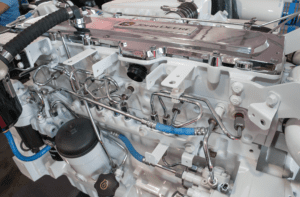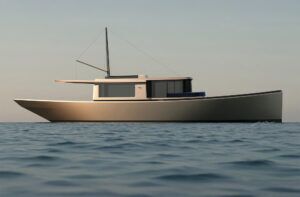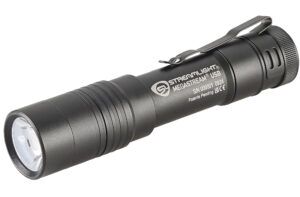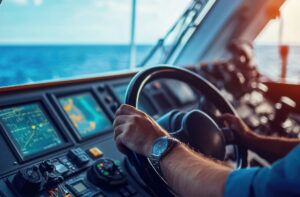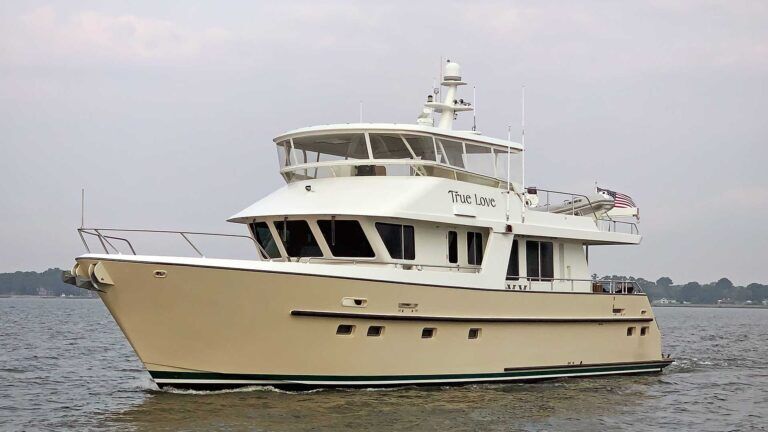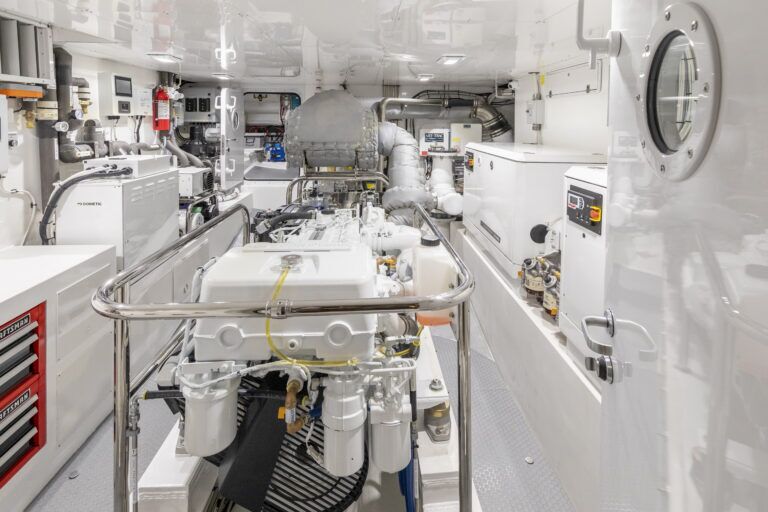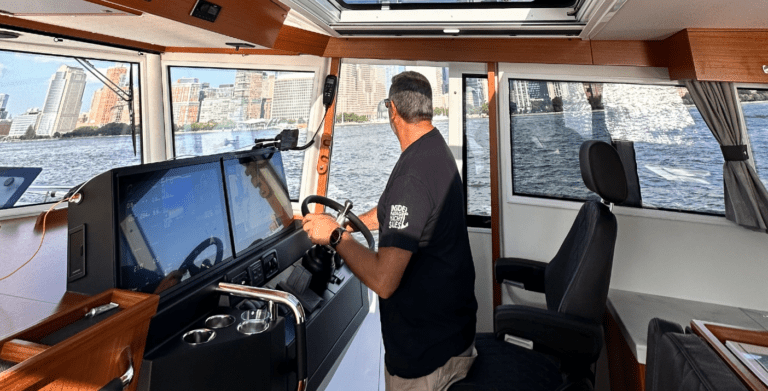It is always amazing to me how quickly marine electronics evolve. It seems that at every boat show there is something new, something better-while at the same time, feature after feature goes from “the latest” to obsolescence in what feels like months.
For the past year, we have been bombarded with press releases about new gear of interest to the cruising boat owner. One example is C-Map’s new Max cartography, which offers a level of contentrich chart information that promises to raise the bar in the pilothouse. Several layers of information provide a range from basic navigation charting to an overload of marine facility phone numbers, land and road details, bridge details, and all sorts of other data combined into a region’s single NT card.
Growler ‘s Furuno NavNet chart plotter is only three years old, but-unfortunately-it can’t run the newest C-Map product, which, in the case of Furuno, requires the newer NavNet vx2 equipment. I soon learned it would be no simple software update to the computer inside the Furuno display, but instead would require replacing the otherwise perfectly good 10-inch display with one that looks identical but has newer internal components. And it would cost me roughly $3,000 to swap the display. Replacing the C-Map NT card with the Max card would be an additional expense.
As one who loves to try new products, I could easily have justified the expense of such a project under the heading of editorial research. But as a boat owner, it struck me that here was yet another example of a recurring question I’ve long pondered: At what threshold or price point can an owner justify upgrading or replacing serviceable and reliable marine electronics and accessories for newer products? Beyond the junkie factor of wanting the latest and greatest no matter what, is there a reasonable process for making such a decision? One that can be successfully defended to one’s spouse? Many years ago, in a lifetime distant from my current state of being, I was an assembly language programmer in telecommunications. As a young and enthusiastic computer programmer, I quite vividly recall an IBM instructor explaining the finer points of system design. He said there was a good yardstick by which to judge a system’s lifespan in a changing business or application environment. He maintained that if the percentage of code needed to change a computer system would exceed 15 percent, no matter the application, it was better to completely redesign the system and write a new one than to patch changes into the current system. That has stuck with me over the years, and I find it somewhat helpful in wrestling with the NavNet vx2 quandary.
In order to find out what today’s version of the 15-percent factor is in the marine electronics market, I first spoke with our technical editor, Steve D’Antonio. Steve has customers at his yard with 20-year-old radar units that work just fine. These folks don’t see the point in replacing reliable, wellunderstood radar with new equipment. And Steve never pushes his customers one way or the other, as it is a personal decision.
Furuno’s advertising and communications manager, Jeff Kauzlaric, was surprisingly candid when I called him about this question. He did chafe a bit about the use of the term “upgrade,” however-obviously a point brought home after many hours of booth duty at boat shows around the country. He began by clarifying the terms of this discussion, telling me that the term “upgrade” is really valid only for software changes; swapping marine hardware is considered “replacement.” Fair enough.
Jeff explained that the change in architecture from NavNet (such as the plotter on Growler) to NavNet vx2 was done to take advantage of newer technology, both for C-Map NT Max and for Navionics Gold cartography. He went on to say that Furuno’s engineering of NavNet vx2 was done to allow swapping the display units only, keeping existing radar, GPS, and other networked components in the system. This provides an opportunity to make the jump in technology without having to replace an entire networked system of marine electronics. For a multiple-display system on a larger boat, however, replacing all of the displays can still be an expensive proposition.
In the case of Growler ‘s single-display system, is it worth $3,000 to get the newer technology? “You have to look at the features,” Jeff said. “In the case of NavNet versus NavNet vx2, the differences are not that huge, although AIS is available on the newer equipment.” In my case, Jeff did not see much advantage of making the change. Maybe in a couple of years, when the list of features expands further, doing so may be justified.
He went on to explain that when the entire architecture changes, it is often a different matter, and one can really justify the newer equipment only when it is time to buy a new boat. A good example is Raymarine’s HSB2 technology versus its latest E-Series navigation electronics. The architecture is so different that transitioning to the newer version requires replacement of the entire system. And the newer equipment may not fit the available helm space, or the holes left in the console from removing older displays and controls.
“Be careful to evaluate the new features,” Jeff said. “Is the redraw speed faster? Are the chart detail and information much better? Is the fishfinding better? Are there more options than what I currently have? Does this offer more flexibility for the future?” All are excellent questions. In the case of Growler ‘s NavNet update, an AIS receiver on a boat represents a definite safety factor.
“Ultimately, it’s a personal decision,” Jeff concluded. “Gadget-crazy people want the latest, but most people don’t need to swap out perfectly good equipment for newer, but essentially similar, equipment.
“It’s the nature of electronics-look at cell phones and all of the features they have today. It’s been like this for a long time.”
ComMar’s Steve Davis, industry rep for Icom, offered that if something isn’t broken, why replace equipment? He did say that some things do wear out, which may change the equation. For instance, an Icom handheld VHF radio’s battery may only last five or six years, and the cost of a replacement battery may be half the cost of buying a new radio. That may be an instance in which to consider buying new. (Fixed-mount radios last a long time, but Steve told me that if a radio is over 10 years old, it should be tested for receiver and transmitter performance.)
I also discussed the subject of electronic charting software with Jeff Hummel. Jeff has been PMM’s electronics editor for the last couple of years and has recently left us to become director of sales and marketing for Rose Point Navigation Systems. Jeff was heavily involved with the development of Nobeltec’s VNS and Admiral navigation systems and is an authority on marine navigation. When it comes to electronics and navigation systems, I’ve met few people who are more knowledgeable than Jeff Hummel.
“In the last couple of years, there have been some huge advances that make it worth the cost of updating one’s electronics,” Jeff said. “New heading sensors, radar overlay, and AIS are all worth a look.
“There are ‘noise level’ upgrades in navigation software that tweak little features and fix bugs. But when a new feature is introduced, such as AIS, I would definitely make the investment. If you are comfortable with your older-style radar, fine. But with new features like ARPA and MARPA, I say go for it.”
When it comes to paper and electronic charts, Jeff says it is important to have the most current. “I don’t trust charts, or any single piece of gear. I put it all together and that’s what I trust.”
Jeff recalls the early days at Nobeltec, when founder Jay Phillips had a rule for each new release of Nobeltec software: There had to be three features that really knocked your socks off to justify spending the money for the new release. Three features that are so obvious one is simply compelled to buy it. That’s not a bad rule for the consumer, either.
“It’s a very good value if you spend $100 for an upgrade that has really new and useful features,” Jeff said. And he is certain there are many features still out there to develop. Electronic charting isn’t done.
Jeff also mentioned that when people replace marine electronics, it is a good thing to leave the old equipment as backup, if there is room for it. Redundancy is a good thing.
I’ve concluded that Growler ‘s helm will stay the same for now, although I’ll keep current on the C-Map NT card, paper charts, and software. But I will keep an eye on the horizon for features that will eventually make me safer, more confident, and a better skipper on the water. I guess it is still a 15-percent kind of thing.



